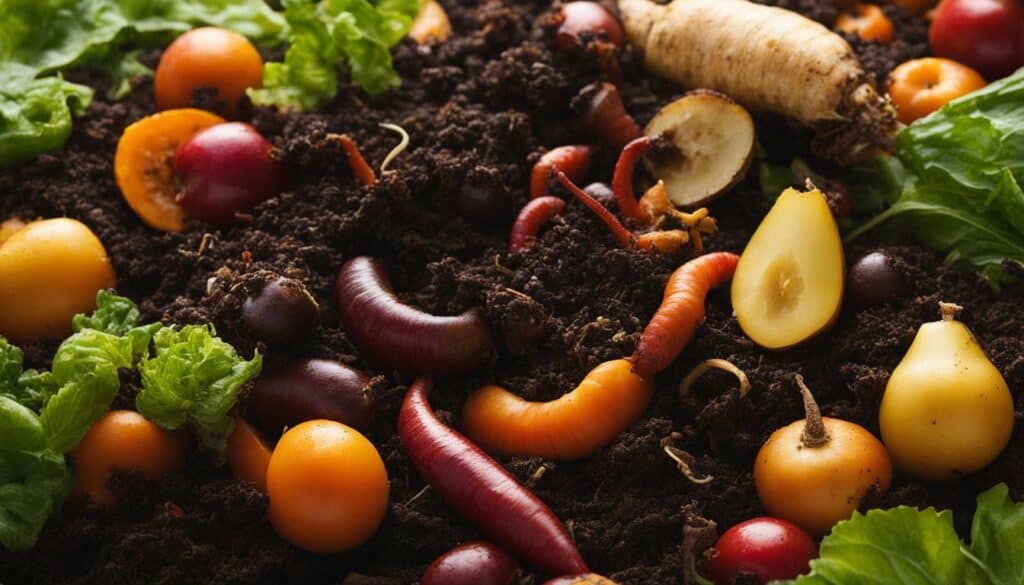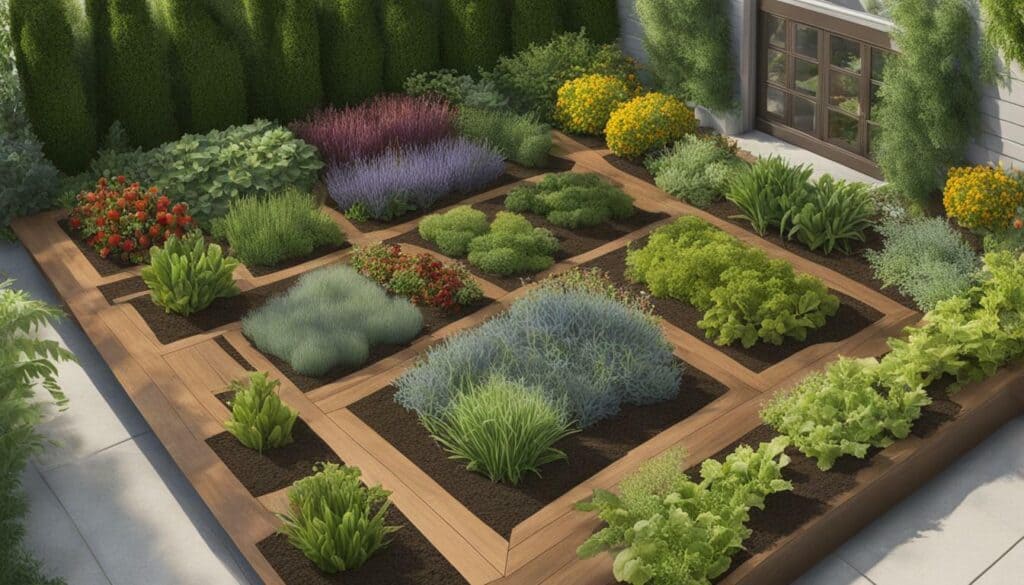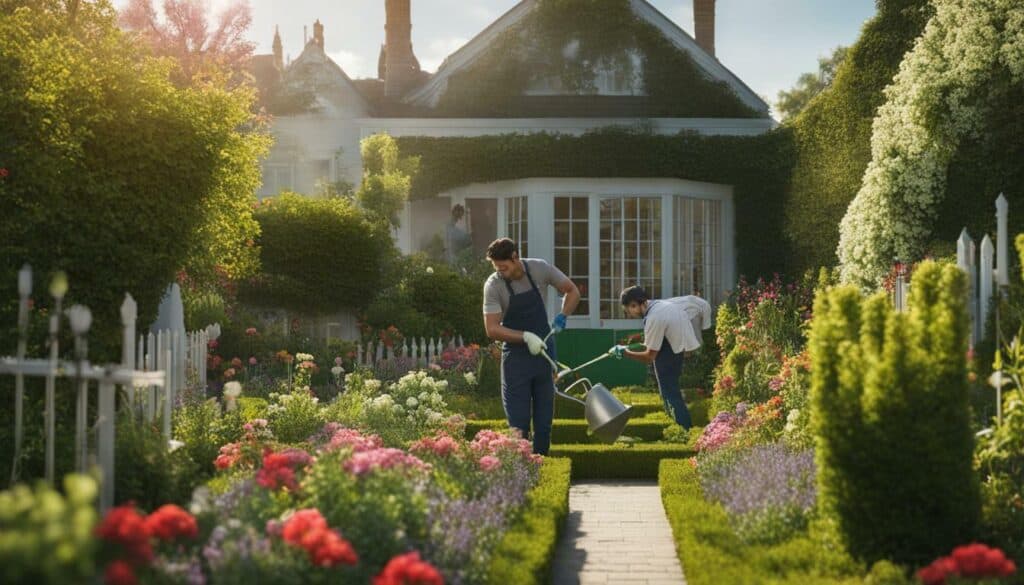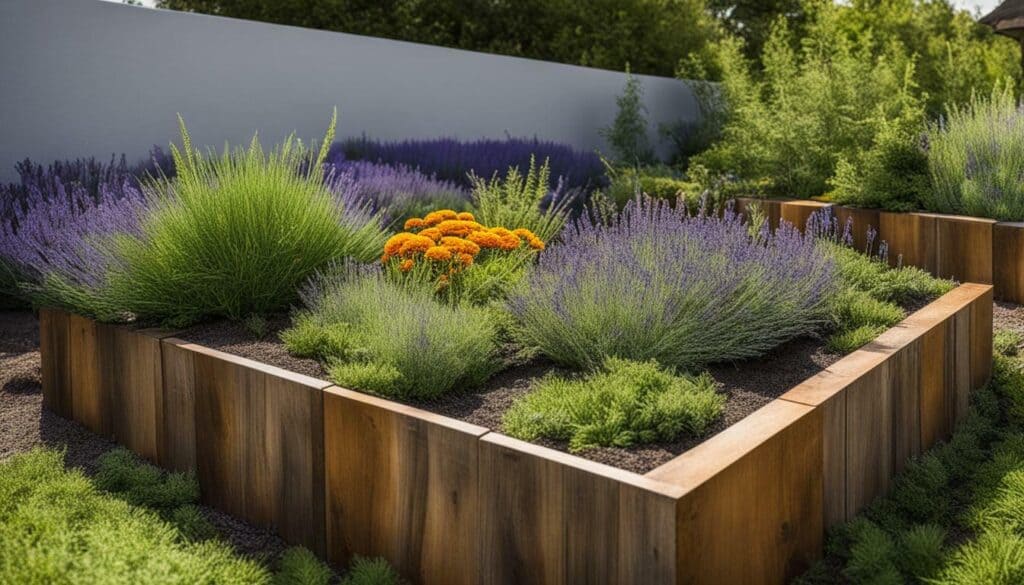To kickstart your gardening journey, it is important to have a beginning garden plan. A well-thought-out plan can increase your chances of success and provide a more organized approach to gardening.
Beginner-friendly plants like tomatoes, basil, and marigolds are ideal for novice gardeners. Consider factors such as sunlight availability and water demands when selecting the perfect plants for your garden.
Master soil science and composting by understanding soil types, drainage, and nutrient balance. Enhancing your soil’s fertility through composting kitchen scraps and garden waste is crucial for your plants’ growth.
Equip yourself with essential tools like a spade, pruners, gloves, and a watering can for a smoother gardening experience. Opting for sturdy, high-quality tools will be a worthwhile investment.
Craft your garden haven by designing a layout that maximizes sunlight exposure and optimizes space. Raised beds are ideal for beginners. Adequately prepare the soil and arrange plants with their growth habits in mind.
Water wisely by watering deeply yet infrequently to encourage deep root growth. Mulching can help retain moisture and curb weed growth. Regular maintenance is crucial for a thriving garden. Trim away dead branches, tackle weeds, and stay vigilant for signs of ailments.
Pest management is important to protect your plants. Swiftly identify and address pest issues, and explore eco-friendly solutions like neem oil or beneficial insects.
Gardening offers a variety of styles, from structured to cottage gardens. Select a style that resonates with your taste and suits your space and preferences.
Even with limited outdoor space, you can still garden through container gardening. Many vegetables thrive indoors with proper light and care. Different seasons welcome different plant varieties, so research optimal planting times to maximize growth.
Join local gardening clubs or online forums to share experiences and learn from seasoned enthusiasts. Gardening takes time and patience, so embrace the challenges and assemble your garden one piece at a time.
For beginners on a budget, shopping smart can help to trim costs. Instead of buying expensive plant starts, opt for seeds and check out local nonprofits or friends for plants or cuttings. Thrift stores and estate sales are great places to find affordable gardening tools and pots.
Seize the opportunity to kickstart your green thumb with a beginning garden plan. Enjoy the process and watch your garden thrive. Happy gardening!
Key Takeaways
- Choose beginner-friendly plants that suit your location.
- Master soil science and composting to enhance soil fertility naturally.
- Equip yourself with essential gardening tools.
- Design a garden layout that maximizes sunlight exposure and optimizes space.
- Water wisely by watering deeply yet infrequently.
- Practice regular maintenance and cultivate natural pest management techniques.
- Explore different gardening styles and consider indoor gardening options.
- Research optimal planting times and harvesting tips.
- Join local gardening communities and budget-friendly tips.
Selecting the Right Plants for Your Space and Climate
When creating a beginning garden plan, the first step is to carefully select the right plants for your space and climate. This decision is crucial, as it can determine the success or failure of your garden. Factors such as sunlight availability, water demands, and available space should be considered when selecting plants. It’s also important to choose beginner-friendly plants that are suitable for your specific location.
Healthy soil is essential for your plants to thrive. Understanding soil science, learning what type of soil you have, and improving it over time with composting can enhance fertility. Composting kitchen scraps and garden waste can save money and promotes eco-friendly gardening practices.
Investing in high-quality gardening tools is recommended to ensure ease and comfort while gardening. Hand tools, gloves, watering cans, and pruning shears are essential for any gardener.
Designing your garden layout to maximize sunlight exposure and optimize space is important. Raised beds are beginner-friendly, and container gardens can be utilized in small spaces. Proper watering techniques are crucial for your plants’ health. Deep watering encourages root growth, and mulching helps retain moisture and control weeds.
Regular maintenance, including pruning and natural pest management, is necessary for a healthy garden. Different gardening styles can be explored to find your preferences. Succulents and herbs can be grown indoors for those with limited outdoor space.
Researching optimal planting times for specific plants in different seasons is highly beneficial. Harvesting should be done when fruits and veggies are ripe. Education on identifying and addressing common issues is important. Joining gardening communities and seeking online resources can provide further guidance.
Container gardening is a great option for those with limited outdoor space. Watering frequency depends on the plant type and weather conditions, but watering deeply is optimal. Eco-friendly pest control methods, like neem oil, are advised. Vegetables can be cultivated indoors with proper care.
Planning, budgeting, and shopping smartly can help control gardening costs. Assembling a garden over time and seeking used tools and pots can save money. Gardening requires patience, and planting during August and September provides optimal conditions for plant health. Preparing garden beds and composting during these months is beneficial. Fall is a great time to plant certain vegetables for a delicious harvest.
Research and planning for your dream garden is recommended. Early detection and prevention of garden pests and diseases are crucial. Taking advantage of the opportunity to prepare for a garden in August and September sets the foundation for a successful gardening journey.
Understanding Soil Science and Composting
To create a thriving garden, it is essential to understand soil science and implement composting practices. Soil types, drainage, and nutrient balance are all critical factors in the fertility of your garden. A basic understanding of soil science can help you identify your soil type and determine the best plants to grow, as well as how to improve soil quality.
Composting your kitchen scraps, yard waste, and other organic material is a cost-effective and eco-friendly way to enhance soil fertility. Compost is nutrient-rich and can improve soil texture, water retention, and drainage. Plus, it’s a great way to reduce household waste and promote sustainability. With a variety of composting methods available, from traditional backyard composting to worm composting, it’s easy to find a solution that works for any space or lifestyle.
When preparing your soil for planting, make sure you have the essential gardening tools, such as spades, pruners, gloves, and watering cans. With the right tools, you can efficiently and safely maintain your garden.
| Soil Prep Tools | Composting Tools |
|---|---|
| Spade | Compost bin |
| Fork | Food scraps |
| Gloves | Garden waste |
| Watering can | Compost activator |
| Pruners | Worm bin |
Maximizing sunlight exposure is also essential for plant growth. When planning your garden layout, choose a location that receives full sun. If you have limited space, consider raised beds or container gardens. Mulching is a great way to retain moisture and control weeds while also enhancing soil fertility.

Regular maintenance, such as trimming and pest control, is necessary for a thriving garden. Joining gardening communities and seeking guidance from experienced gardeners can provide valuable insights. Even with limited outdoor space, container gardening is a viable option. You can successfully cultivate vegetables indoors with proper light and care.
For successful harvests, research optimal planting times and harvest fruits and vegetables when they are ripe. Identifying and addressing plant issues and joining gardening communities can provide valuable support. Finally, remember that gardening takes time and patience, but the rewards are worth the effort.
Equipping Yourself with Essential Gardening Tools
Having the right gardening tools is crucial for a successful gardening experience. Regardless of the size of your garden, it’s important to have certain basic tools, including a spade, pruners, gloves, and a watering can. Before purchasing tools, assess the type of gardening you plan to do and invest in quality items that will last.
Consider the size of your garden when selecting gardening tools. If you have a small garden or balcony, opt for lightweight, compact tools that will be easy to manage. If you have a larger area, invest in sturdy, long-handled tools to make gardening less strenuous.
When purchasing gardening gloves, choose ones that fit snugly and provide ample protection. Heavy-duty gloves made of sturdy, breathable material are ideal for handling prickly plants, while waterproof gloves are the perfect choice for rainy days.
| Tool | Purpose |
|---|---|
| Spade | Used for digging and turning soil |
| Pruners | Used for trimming and shaping plants |
| Gloves | Protects hands from thorns and blisters |
| Watering Can | Used for watering plants |
Other important aspects of gardening include selecting the right plants for your space and climate, understanding soil science and composting, crafting a garden layout, and learning about watering and pest management. Joining local gardening clubs and online forums can provide valuable insights and guidance for beginners.
If you have limited outdoor space, container gardening is a great option. This method allows you to grow plants in pots or other containers, making it perfect for balconies or small gardens.
When it comes to watering, the frequency depends on factors like plant type and weather conditions. It’s important to water deeply and infrequently to encourage deeper root growth. Additionally, consider eco-friendly solutions like neem oil for natural pest control.
Researching planting times and harvesting tips is also important for a successful garden. August and September are optimal months for planting as they provide optimal conditions for plants to thrive. This also allows ample time to prepare garden beds, research and plan, and tackle garden pests and diseases.
In conclusion, equipping yourself with essential gardening tools and knowledge will set the foundation for a vibrant and successful garden. So, gather your tools and get ready to create your own green oasis!
Crafting a Garden Layout and Optimizing Sunlight Exposure
Designing a garden layout that maximizes sunlight exposure is key to a successful beginning garden plan. When planning your garden, consider the amount of sunlight your plants will receive throughout the day. Most vegetables require at least six hours of direct sunlight daily, while some fruits such as apples and figs require up to eight hours of direct sunlight.
There are various garden layouts to choose from, such as raised beds, container gardens, and traditional row planting. Consider the space you have available and the plants you want to grow when selecting a layout. Raised beds are a popular option for beginners, as they provide good drainage and make it easy to control soil quality. Container gardens are ideal for those with limited space, as they can be placed on patios, balconies, and even windowsills. Traditional row planting is suitable for larger gardens and allows for easy access to plants for watering and maintenance.
When selecting a location for your garden, choose a spot that receives adequate sunlight and has good drainage. Avoid placing your garden under trees or in areas with poor drainage, as excess moisture can lead to root rot and other plant diseases.

Maximizing sunlight exposure can be achieved by placing plants that require the most sunlight in areas that receive direct sunlight for the longest periods of time. For example, place tall plants on the north side of your garden to avoid shading smaller plants that require more sunlight. Additionally, consider using trellises and stakes to support climbing plants, which can free up space in your garden and make it easier to optimize sunlight exposure.
Proper garden layout and sunlight exposure are critical components of a beginning garden plan. By considering factors such as space availability, plant selection, and sunlight exposure, you can create a garden that thrives and produces a bountiful harvest.
Watering, Maintenance, and Pruning Tips for a Thriving Garden
Proper watering, maintenance, and pruning are essential for nurturing a flourishing garden. Watering your plants regularly is important, but it’s equally important to water deeply yet infrequently. This encourages deep root growth, making your plants more drought-resistant. Mulching can help retain moisture in the soil and suppress weed growth. Organic mulches like shredded leaves, straw, or grass clippings can provide added nutrients as they break down.
Regular maintenance is crucial for the health of your garden. Regularly trimming away dead branches and tackling weeds can help keep your plants healthy and reduce the risk of diseases. Be sure to check for pests and diseases regularly and address any issues promptly. Consider exploring eco-friendly solutions and natural pest control methods instead of resorting to harmful chemicals.
Pruning Tips
Proper pruning techniques help promote healthy growth and shape plants. Begin by removing any dead or diseased wood, then move on to trimming new growth back to a node or bud. When pruning, be sure to use sharp, clean tools to avoid damaging the plant. Different plants require different pruning techniques, so be sure to do your research before getting started.

Watering, maintenance, and pruning are essential aspects of maintaining a thriving garden.
Overall, by following these watering, maintenance, and pruning tips, gardeners can create a thriving garden. Taking the time to care for your plants properly can be incredibly rewarding and lead to a beautiful and productive garden.
Natural Pest Management for a Healthy Garden
Keeping pests at bay in a natural way is vital for a thriving garden. As a beginner gardener, it’s crucial to identify and address any pest issues quickly to prevent damage to your plants. One effective way to manage pests naturally is by using eco-friendly solutions like neem oil, insecticidal soaps, and diatomaceous earth. These solutions are safe for plants and the environment and won’t harm beneficial insects.
Another natural pest management technique is introducing beneficial insects to your garden, such as ladybugs, lacewings, and praying mantis. These insects feed on pests like aphids and caterpillars, reducing the need for chemical pesticides.
It’s also a good idea to practice preventative measures, such as regularly removing weeds, dead plant material, and other debris that can harbor pests. Additionally, rotating crops and using companion planting can help deter pests and promote healthy plant growth.
Joining gardening communities and online forums can provide valuable insights and guidance for managing pests effectively. Members can share their experiences with natural pest control methods and provide recommendations for specific pest issues.

“Natural pest control methods play a crucial role in maintaining the health of your garden. By embracing eco-friendly solutions and introducing beneficial insects, you can protect your plants and the environment.”
Exploring Different Gardening Styles and Indoor Gardening
Gardens can be created in various styles and can even thrive indoors for those with limited outdoor space. As a beginner, it’s essential to select plants that suit your climate and space. Some beginner-friendly plants include tomatoes, basil, and marigolds.
Understanding soil science and composting is crucial for healthy soil. With the right tools, like spades, pruners, and watering cans, you’ll have a successful gardening experience. Designing your garden layout to maximize sunlight exposure and space is also crucial. Different gardening styles, from structured to cottage gardens, offer a variety of design possibilities.
Indoor gardening is a great option for those with limited outdoor space. Plants like succulents and herbs thrive indoors with proper care and lighting. Container gardening can also be an option for those with limited space.
Joining gardening communities and online forums can provide valuable insights and guidance, as well as connecting with like-minded gardeners. Watering plants deeply but infrequently and being diligent in regular maintenance are key to ensuring a thriving garden.
Identifying and addressing pest issues naturally is recommended before resorting to chemicals. Different seasons call for different plant varieties, so researching optimal planting times is crucial. Addressing common issues like yellowing leaves, pests, and diseases is part of the gardening process.
Harvesting is the gratifying outcome of gardening efforts. Natural pest control methods like neem oil should be explored before using chemicals, and many vegetables can be cultivated indoors with proper care and lighting.
Exploring different gardening styles and starting indoor gardening is a fulfilling and rewarding endeavor. By connecting with like-minded gardeners and expanding your knowledge through research and experimentation, your gardening journey can be a long and prosperous one.

“Gardening is a medicine that does not need a prescription…and with no limit on dosage.”
– Unknown
Researching Planting Times and Harvesting Tips
Researching planting times and learning effective harvesting techniques are crucial for a fruitful garden. August and September are the optimal months to kickstart your gardening journey, as the cooler temperatures provide ideal conditions for planting. The warm soil and cool air allow seeds and transplants to establish themselves before winter, resulting in healthier growth in the spring.
Before you start planting, it’s important to prepare your garden beds and amend the soil. Remove any remaining summer crops and weeds, and enrich the soil with compost, organic matter, and fertilizers. This ensures that the soil will be ready to nourish your plants when the growing season begins.
Fall planting presents another opportunity for delicious harvests. Vegetables like lettuce, spinach, kale, and radishes thrive in the cooler temperatures of fall and can be harvested throughout the season. Planting these crops in August or early September allows them to mature before the first frost, ensuring a tasty harvest.
Take the time to research and plan your garden during these months. Select the plants that suit your gardening space, preferences, and climate. Create a garden layout and order seeds or transplants. Planning ahead can increase your chances of success and yield a bountiful harvest.
Additionally, August and September are the perfect months for composting. Fallen leaves and garden debris accumulate during this time, making it an ideal opportunity to start a compost pile or bin. Composting not only reduces waste but also provides nutrient-rich compost for your garden next year.
Early detection and prevention of garden pests and diseases is crucial. Observe your garden closely during August and September to identify any potential issues and take appropriate measures to protect your plants. By doing so, you can prevent any damage to your plants and ensure a healthy crop.
By researching planting times and harvesting tips, you can set yourself up for success in your gardening journey. Take advantage of the cooler temperatures and optimal conditions of August and September to prepare your soil and plan your harvests. With proper research and planning, you can enjoy a thriving garden and a bountiful harvest. Happy gardening!

Joining Gardening Communities and Budget-Friendly Tips
Joining gardening communities and being resourceful with your budget are valuable aspects of a successful beginning garden plan. As a novice gardener, connecting with other enthusiasts in local clubs or online forums can provide a wealth of knowledge and advice. By learning from experienced gardeners, you can avoid costly mistakes and gain insights into effective techniques that work well for your area.
Implementing budget-friendly tips can also help save money without sacrificing the quality of your garden. Start by determining your top priorities and create a budget that aligns with your goals. Opt for seeds instead of expensive starts, and source soil and compost from local resources like farms or landfills. Shopping for used gardening hardware from estate sales or thrift stores can also be a great way to save money while still obtaining quality equipment.
Assembling the garden over time can also be cost-effective. Plants are often cheaper off-peak, and outdoor furniture is less expensive in the fall. August and September are great months to kickstart your gardening journey as cooler temperatures provide optimal planting conditions and ample time for garden bed preparation. Fall planting allows for delicious harvests of vegetables like lettuce, spinach, kale, and radishes. Additionally, this time can be used for research, planning the dream garden layout, and starting composting to enrich the soil for the following year.
By tackling garden pests and diseases early on, you can ensure your plants remain healthy and productive. Natural pest control methods, like companion planting and homemade insecticidal soaps, can be effective and more cost-efficient than chemical alternatives.
By following these tips, novice gardeners can successfully join gardening communities, save money, and create their dream gardens.

Conclusion
So, don’t wait any longer, grab your gardening gloves and start your gardening expedition! Gardening is a fulfilling and rewarding pursuit for individuals of all ages and backgrounds. With a reliable beginning garden plan, selecting the right plants for your climate and space, understanding soil science and composting, acquiring essential gardening tools, designing your garden layout, and exploring different gardening styles, beginners can embark on their gardening journey successfully.
It is important to remember that gardening requires patience and perseverance, and it may take time for your garden to flourish. However, with the right guidance and support from gardening communities, anyone can achieve a thriving and healthy garden. Don’t let a limited budget discourage you, seek out cost-effective methods for purchasing plants and supplies, and embrace the challenge that comes with gardening. With dedication and hard work, you’ll be rewarded with a vibrant and beautiful garden.
FAQ
Q: What is a beginning garden plan?
A: A beginning garden plan is a well-thought-out strategy that outlines the steps and considerations for starting a garden. It involves selecting the right plants, understanding soil science, equipping yourself with the necessary tools, and planning the layout of your garden.
Q: Why is a beginning garden plan important?
A: Having a beginning garden plan increases your chances of gardening success. It helps you stay organized, ensures that you choose plants suitable for your space and climate, and allows you to optimize sunlight exposure and soil health.
Q: How do I select the right plants for my space and climate?
A: When choosing plants, consider the space available in your garden and the climate conditions in your area. Look for plants that are beginner-friendly and suitable for your specific location. Local nurseries and online gardening resources can provide guidance.
Q: What do I need to know about soil science and composting?
A: Understanding soil science is essential for healthy plant growth. Learn about soil composition, pH levels, and nutrient content. Composting is a natural way to improve soil fertility. Compost kitchen scraps, yard waste, and other organic materials to enrich your soil.
Q: What are the essential gardening tools for beginners?
A: Essential gardening tools include hand tools (such as a trowel and a hand rake), gloves, watering cans or a hose, and pruning shears. Look for quality tools that fit your budget. They will make gardening tasks easier and more efficient.
Q: How do I craft a garden layout and optimize sunlight exposure?
A: Plan your garden layout to make the most efficient use of space and provide proper sunlight exposure for your plants. Consider raised beds or container gardens if you have limited space. Place taller plants where they won’t shade smaller ones.
Q: What are some watering, maintenance, and pruning tips for a thriving garden?
A: Water deeply and infrequently to encourage deep root growth. Regularly maintain your garden by weeding, fertilizing, and pruning as needed. Proper pruning helps shape plants and enhances their overall health and productivity.
Q: How can I manage pests in my garden using natural methods?
A: Natural pest control methods, such as companion planting, homemade insecticidal soaps, and attracting beneficial insects, can help manage pests without relying on chemicals. These methods are safer for the environment and promote a healthy garden ecosystem.
Q: What are some different gardening styles I can explore?
A: Gardening styles can range from traditional to contemporary. Consider artistic or edible gardens, vertical gardening, or even hydroponics. Indoor gardening is also a great option for those with limited outdoor space.
Q: How do I research optimal planting times and harvesting tips?
A: Researching planting times specific to your region and crop preferences is crucial for successful gardening. Learn about the recommended sowing and harvesting periods for different plants. Gather tips on proper harvesting techniques for each crop.
Q: How can joining gardening communities benefit me as a beginner?
A: Joining local gardening communities provides a support network and opportunities for knowledge sharing. Experienced gardeners can offer advice and guidance, making your gardening journey more enjoyable and rewarding. You can also participate in community gardening events and workshops.
Q: How can I garden on a budget?
A: Gardening on a budget is possible by shopping smart and looking for cost-saving options. Choose seeds instead of starts, as they are more affordable. Consider buying used gardening supplies or borrowing from friends. This can help reduce costs while still allowing you to enjoy gardening.
How Can I Start Flower Gardening as a Beginner with a Garden Plan?
Starting flower gardening as a beginner with a garden plan can be an exciting endeavor. To begin, consider the location of your garden and the type of flowers you wish to grow. Research flower gardening tips for beginners to understand soil conditions, sunlight requirements, and watering needs. Sketch out a garden plan, allocating space for each flower variety. With patience and care, you will soon see your garden blossom into a beautiful haven of vibrant blooms.
Source Links
- https://medium.com/@mohammed.touson/gardening-for-beginners-a-comprehensive-guide-to-cultivating-your-green-thumb-8bfd4f73e3a9
- https://www.usatoday.com/story/money/2019/05/24/gardening-tips-how-to-control-costs/1198397001/
- https://civn.org/get-ready-for-your-green-thumb-august-and-september-are-the-best-time-to-start-preparing-for-your-beginning-garden/
- https://www.onegreenplanet.org/lifestyle/how-to-find-your-green-thumb-and-start-a-garden/
- https://www.thegardencontinuum.com/blog/choose-the-right-plant-for-the-right-place-in-your-landscape
- https://www.realhomes.com/advice/how-to-choose-plants-for-your-garden
- https://www.apartmenttherapy.com/choosing-the-right-plants-for-your-space-and-lifestyle-228843
- https://hort.extension.wisc.edu/articles/beginning-vegetable-garden-basics-site-selection-and-soil-preparation/
- https://extension.psu.edu/soil-management-in-home-gardens-and-landscapes
- https://www.nature.org/content/dam/tnc/nature/en/documents/nature-lab-lesson-plans/NLGardens-Soil.pdf
- https://www.eatingwell.com/article/17068/the-only-tools-you-need-to-start-a-garden/
- https://www.gardenersworld.com/product-guides/growing/essential-gardening-tools-list/
- https://www.washingtonpost.com/home/2023/02/28/essential-garden-tools/
- https://www.summerwindsnursery.com/az/inspire/blog/guide-to-mapping-garden-sun-exposure/
- https://plantperfect.com/how-to-design-the-perfect-vegetable-garden-layout/
- https://growingthehomegarden.com/plan-for-sunlight-in-the-garden/
- https://www.gardendesign.com/how-to/
- https://www.bhg.com/gardening/yard/garden-care/gardening-tips-for-every-gardener/
- https://www.createmygarden.net/august-5-helpful-tips-for-a-thriving-garden/
- https://journeywithjill.net/gardening/2019/08/27/pest-control-without-pesticides-for-a-healthy-organic-garden/
- https://journeywithjill.net/gardening/2023/05/31/pest-control-tips-for-the-beginning-gardener/
- https://www.tenthacrefarm.com/preventing-garden-pests/
- https://www.planetnatural.com/garden-planning/
- https://www.homesandgardens.com/advice/how-to-plan-a-garden
- https://www.homesandgardens.com/advice/planning-a-kitchen-garden
- https://www.almanac.com/vegetable-gardening-for-beginners
- https://www.realsimple.com/home-organizing/gardening/outdoor/month-by-month-vegetable-gardening-guide
- https://www.bhg.com/gardening/vegetable/vegetables/planning-your-first-vegetable-garden/
- https://content.ces.ncsu.edu/how-to-organize-a-community-garden
- https://www.tenthacrefarm.com/how-to-start-a-garden-on-a-budget/
- https://www.morningagclips.com/a-guide-to-starting-a-community-garden/
- https://content.ces.ncsu.edu/home-vegetable-gardening-a-quick-reference-guide
- https://www.bhg.com/gardening/yard/garden-care/ten-steps-to-beginning-a-garden/
- https://bonnieplants.com/blogs/garden-fundamentals/lay-vegetable-garden





Leave a Reply